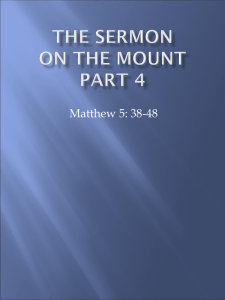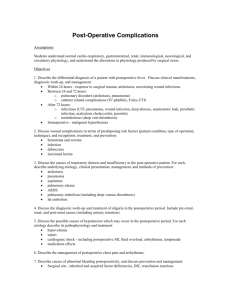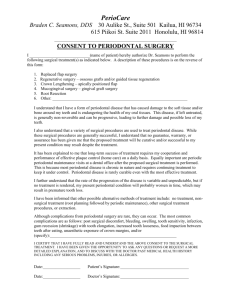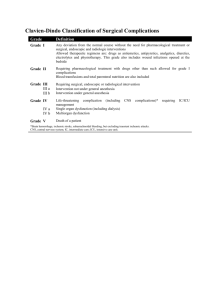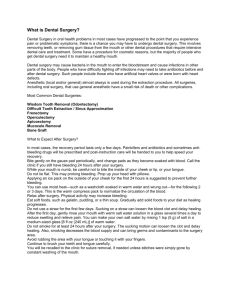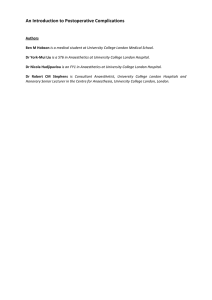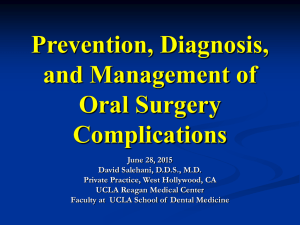See the programme
advertisement
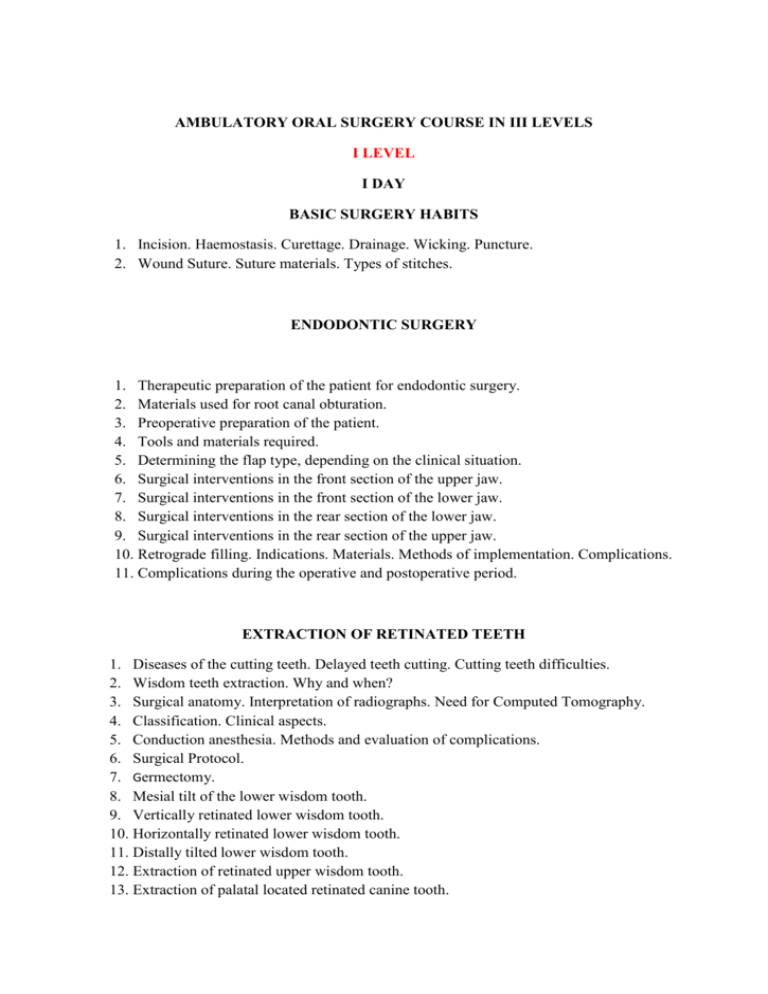
AMBULATORY ORAL SURGERY COURSE IN III LEVELS I LEVEL I DAY BASIC SURGERY HABITS 1. Incision. Haemostasis. Curettage. Drainage. Wicking. Puncture. 2. Wound Suture. Suture materials. Types of stitches. ENDODONTIC SURGERY 1. Therapeutic preparation of the patient for endodontic surgery. 2. Materials used for root canal obturation. 3. Preoperative preparation of the patient. 4. Tools and materials required. 5. Determining the flap type, depending on the clinical situation. 6. Surgical interventions in the front section of the upper jaw. 7. Surgical interventions in the front section of the lower jaw. 8. Surgical interventions in the rear section of the lower jaw. 9. Surgical interventions in the rear section of the upper jaw. 10. Retrograde filling. Indications. Materials. Methods of implementation. Complications. 11. Complications during the operative and postoperative period. EXTRACTION OF RETINATED TEETH 1. Diseases of the cutting teeth. Delayed teeth cutting. Cutting teeth difficulties. 2. Wisdom teeth extraction. Why and when? 3. Surgical anatomy. Interpretation of radiographs. Need for Computed Tomography. 4. Classification. Clinical aspects. 5. Conduction anesthesia. Methods and evaluation of complications. 6. Surgical Protocol. 7. Germectomy. 8. Mesial tilt of the lower wisdom tooth. 9. Vertically retinated lower wisdom tooth. 10. Horizontally retinated lower wisdom tooth. 11. Distally tilted lower wisdom tooth. 12. Extraction of retinated upper wisdom tooth. 13. Extraction of palatal located retinated canine tooth. 14. Complications during the operative and postoperative period. II DAY 1. LIFE-SURGERY 2. Discussing surgeries. II LEVEL PREPROSTHETIC SURGERY I DAY 1. Oral soft tissue anatomy. 2. Bone tissue anatomy. 3. Soft tissue corrections. Frenulotomy. Removal of gingival-buccal connections. Vestibuloplastics. 4. Bone corrections. Alveolar plastics. Removal of exostosis. Removal of torus palatinus and torus mandibulae. 5. Complications during the operative and postoperative period. USE OF DENTAL LASERS IN AMBULATORY ORAL SURGERY 1. 2. 3. 4. 5. 6. 7. Types of dental lasers used in practice. Diode laser. Er-YAG. NdYag. YSGG Laser. Characteristics of a laser apparatus. Advantages of using a laser apparatus. Soft tissue manipulations performed with a laser apparatus. Bone manipulations performed with a laser apparatus. Complications during the operative and postoperative period. Working on a model. II DAY 1. LIFE-SURGERY. 2. Discussing surgeries. III LEVEL I DAY USE OF BONE RESTORATIVE MATERIALS IN ORAL SURGERY 1. General information. 2. Autografs. 3. Allografts. 4. Xenografts. 5. Alloplastic materials. 6. Bone-restorative materials used after tooth extraction to preserve the alveolar ridge. 7. Increase in height and width of the alveolar ridge. 8. Guided bone regeneration. 9. Placement of a dental implant in the aesthetic field. 10. Sinus floor augmentation. 11. Block grafting. 12. Transposition of n.alveolaris inf. 13. Bone builder. 14. Complications during the operative and postoperative period. II DAY 1. LIFE-SURGERY. 2. Discussing surgeries. 3. Awarding certificates. I level – 500 lev II level – 500 lev III level – 650 lev Certificates are awarded at the end of the course.

